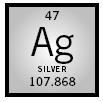Silver

MELTING POINT:
961°C
BOILING POINT:
2,212°C
DENSITY:
10.53 g/cm
3
MOST COMMON IONS:
Ag
+
, Ag
2+
Silver is a precious metal and (like gold and copper) is classified as a coinage metal. The date of its discovery is not known, but it has been identified in jewelry, coins, and religious ornaments dating to more than 2,000 years ago from ancient civilizations in South America, Egypt, Mesopotamia, and China.
Silver exists as two isotopes , 107 Ag and 109 Ag, occurring in similar proportions. It exhibits three valance/ oxidation states: Ag(I), Ag(II), and Ag(III). The chemistry of silver was not well-known before 1980, although silver nitrate was used medicinally in the 1800s. Recent research has recognized the highly reactive nature of the silver ion and its ability to form numerous inorganic and organic complexes (halide, sulfide, nitrate, oxide, and acetylide compounds, cyano-derivatives, olefin complexes, etc.). Ag(II) complexes are less stable than those of Ag(I) and Ag(III), but unlike many other silver compounds are brightly colored red or blue. Silver ion binds readily to proteins in the human body (including albumins and metallothioneins ) and interacts with trace metals in metabolic pathways.
Silver is the sixty-third most abundant metal in Earth's crust; the average concentration of silver in water is 0.5 ppb, in soil it is 10 ppb. It is found naturally as native metal or in ores in which it is complexed with lead, copper, tellurium, mercury, arsenic , or antimony. Silver is found mainly throughout the Americas, Japan, Australia, and central Europe. Extraction is by amalgamation and displacement (using mercury), solution, or smelting methods.
Silver is used in the manufacture of photographic film chemicals such as silver nitrate, as an analytic reagent in organic chemistry, as a catalyst in photo-oxidation reactions, in electrochemical reactions, in nuclear magnetic resonance and analyses, and in silver plating.
Medically, silver is used in the manufacture of bone prostheses, cardiac implants and replacement valves, needles used in ocular surgery, peritoneal catheters, and wound sutures. It is an antiseptic ingredient used in wound management (silver nitrate, siler sulfadiazine, and cerium nitrate). A new generation of sustained silver release products is showing promise in the treatment of skin wounds, skin ulcers, and burns; silver ion is released from the dressings (Acticoat™, Actisorb™, etc.) in the presence of wound fluids, exudates, and is "activated." Activated silver ion is toxic to bacteria and yeasts. Silver is used in the making of dental amalgam fillings. Silver exhibits widespectrum antibacterial activity; it is toxic to bacteria at low concentrations (10 −5 to 10 −7 Ag ions per cell), the so-called oligodynamic effect.
Silver is toxic. Silver nitrate used in antiseptic mouthwashes leads to deposits of silver sulfide in the skin and a slate-gray skin discoloration (known as argyria); argyria is also caused by the colloidal silver used in antiseptics and mouthwashes. Silver absorbed through the skin is deposited in the liver and kidney and complexes with albumin and cellular proteins. Another silver hazard is allergy to silver, occurring as a result of the silver that is used in jewelry, medicinal products, coins, and antiseptics.
Alan B. G. Lansdown
Bibliography
Buckley, W. R.; Oster, C. F.; and Fassett, D. W. (1965). "Localised Argyria: Chemical Nature of the Silver Containing Granules." Archives of Dermatology 92: 697–705.
Lansdown, Alan B. G. (2002). "Silver," Parts 1 and 2. Journal of Wound Care 10: 125–130; 173–177.
Lansdown, Alan B. G.; Myers, S. R.; Clarke, J. A.; et al. (2003). "A Reappraisal of the Role of Cerium in Burn Wound Management." Journal of Wound Care , 12/3: 113–118.
Lowbury, Edmund J. L. (1992). "Special Problems in Hospital Antisepsis." In Principles and Practice of Disinfection, Preservation and Sterilisation, ed. A. D. Russell, W.B. Hugo, and G. A. G. Aycliffe. London: Blackwell Scientific Publications.
Mietzner, S.; Schwille, R. C.; Farley, A.; et al. (1997). "Efficiency of Thermal Treatment and Copper Silver Ionization for Control of Legionnella pneumophila in High Volume Hot Water Plumbing Systems in Hospitals." American Journal of Infection Control 25: 452–457.
Patai, Paul, and Rappaport, Zvi, eds. (1999). The Chemistry of Organic Derivatives of Gold and Silver. Chichester, UK: Wiley.
Thompson, N. R. (1973). "Silver." In Comprehensive Inorganic Chemistry, ed. J. C. Bailar; H. J. Emelius; R. Nyholm; et al. London: Pergamon Press.
Comment about this article, ask questions, or add new information about this topic: